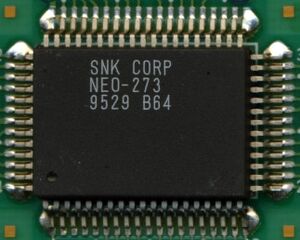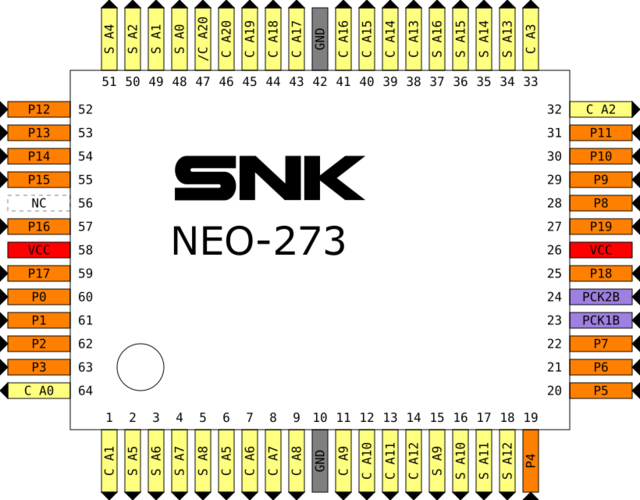NEO-273: Difference between revisions
m (→Pinout) |
(Repair tips) |
||
| Line 8: | Line 8: | ||
}} | }} | ||
The NEO-273 chip is used in cartridges to | The NEO-273 chip is used in cartridges to demultiplex the [[P bus]] to [[C ROM]] and [[S ROM]] addresses (graphics). Ir replaces the discrete 74LS273 and 74LS174 latches that were used in early boards (like [[CHA board|CHA-32]]). | ||
This chip was later | This chip was later superseded by {{Chipname|NEO-CMC}} which performs the same functions along with a lot of other things. | ||
For cartridges that use this chip but have more than 8MiB of sprite graphics data, extra bits were added using discrete chips. An added 74LS74 (2 bits) in [[CHA256]] boards for example increases the C ROM capacity from 8MiB to 32MiB (256Mbits). | For cartridges that use this chip but have more than 8MiB of sprite graphics data, extra bits were added using discrete chips. An added 74LS74 (2 bits) in [[CHA256]] boards for example increases the C ROM capacity from 8MiB to 32MiB (256Mbits). | ||
| Line 19: | Line 19: | ||
* The S ROM address is latched on the rising edge of {{Sig|PCK2B|PCK2B}}. | * The S ROM address is latched on the rising edge of {{Sig|PCK2B|PCK2B}}. | ||
Mapping of the [[P bus]] to the ROM address lines: | |||
{|class="wikitable" | {|class="wikitable" | ||
| Line 29: | Line 29: | ||
|} | |} | ||
P20~23 are left out or routed to additional latches. | Note that A4 ({{Sig|CA4|CA4}}) of the C ROMs and A3 ({{Sig|2H1|2H1}}) of the S ROM are not part of the P bus and come straight from the cartridge edge, bypassing this chip. | ||
P20~23 are left out or routed to additional latches if needed. | |||
An inverted C_A20 signal is available on pin 47 to allow cartridges which use 2MiB C ROMs to switch between 2 pairs without the need for an additional inverter chip. | |||
=Internals= | =Internals= | ||
It includes one 16-bit latch (to address a 128KiB S ROM) and one 20-bit latch (to address 8MiB of 2*16bits [[C ROM]]s). | It includes one 16-bit latch (to address a 128KiB S ROM) and one 20-bit latch (to address 8MiB of 2*16bits [[C ROM]]s). | ||
=Pinout= | =Pinout= | ||
{{Pinout|NEO-273|640}} | {{Pinout|NEO-273|640}} | ||
=Repair= | |||
The NEO-273 doesn't appear to fail often. If some outputs are dead, their pins can be lifted and wired to a 74LS74 (2 outputs), a 74LS171 (4 outputs) or 74LS273 (8 outputs). | |||
* Wire the data input to the appropriate P bus line (see table above) | |||
* Wire the output to the address pad | |||
* Wire the clock to either PCK1B or PCK2B depending on the affected address bus. | |||
* Wire power and don't forget to ground the unused inputs if using a CMOS part. | |||
[[Category:Chips]] | [[Category:Chips]] | ||
[[Category:Repairs]] | |||
Revision as of 02:12, 28 November 2018

| |
| Package | QFP64R |
| Manufacturer | |
| First use | 1992 ? |
| Used on | MVS cartridges |
The NEO-273 chip is used in cartridges to demultiplex the P bus to C ROM and S ROM addresses (graphics). Ir replaces the discrete 74LS273 and 74LS174 latches that were used in early boards (like CHA-32).
This chip was later superseded by NEO-CMC which performs the same functions along with a lot of other things.
For cartridges that use this chip but have more than 8MiB of sprite graphics data, extra bits were added using discrete chips. An added 74LS74 (2 bits) in CHA256 boards for example increases the C ROM capacity from 8MiB to 32MiB (256Mbits).
Demultiplexing
- The C ROM address is latched on the rising edge of PCK1B.
- The S ROM address is latched on the rising edge of PCK2B.
Mapping of the P bus to the ROM address lines:
| P BUS | P19 | P18 | P17 | P16 | P15 | P14 | P13 | P12 | P11 | P10 | P9 | P8 | P7 | P6 | P5 | P4 | P3 | P2 | P1 | P0 |
|---|---|---|---|---|---|---|---|---|---|---|---|---|---|---|---|---|---|---|---|---|
| C address | A3 | A2 | A1 | A0 | A20 | A19 | A18 | A17 | A16 | A15 | A14 | A13 | A12 | A11 | A10 | A9 | A8 | A7 | A6 | A5 |
| S address | A4 | A2 | A1 | A0 | ||||||||||||||||
Note that A4 (CA4) of the C ROMs and A3 (2H1) of the S ROM are not part of the P bus and come straight from the cartridge edge, bypassing this chip.
P20~23 are left out or routed to additional latches if needed.
An inverted C_A20 signal is available on pin 47 to allow cartridges which use 2MiB C ROMs to switch between 2 pairs without the need for an additional inverter chip.
Internals
It includes one 16-bit latch (to address a 128KiB S ROM) and one 20-bit latch (to address 8MiB of 2*16bits C ROMs).
Pinout
Repair
The NEO-273 doesn't appear to fail often. If some outputs are dead, their pins can be lifted and wired to a 74LS74 (2 outputs), a 74LS171 (4 outputs) or 74LS273 (8 outputs).
- Wire the data input to the appropriate P bus line (see table above)
- Wire the output to the address pad
- Wire the clock to either PCK1B or PCK2B depending on the affected address bus.
- Wire power and don't forget to ground the unused inputs if using a CMOS part.
